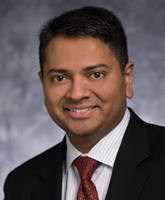Biosimilars: A Brief Manifesto of Morality And Markets
By Louis Garguilo, Chief Editor, Outsourced Pharma

Enhancing free-market capitalism and competition, assisting financially teetering global healthcare systems and empowering patients, are all just in a day’s work for Sumant Ramachandra.
He’s an MD, PhD, MBA, and senior vice president and chief scientific officer at Hospira, Inc. Awaiting you below is nothing less than his manifesto for biosimilars in our lives.
Manifesto, but of course not gospel. Some may not be persuaded to his point of view. In fact, I’ll consider working with any reader who wants to frame a divergent perspective for a future article. Send me an email.
But I believe even those readers with other notions about biosimilars will benefit from listening to Sumant. I had, and I did. In part one of a two-part article, we’ll lay out broader themes (the manifesto). Part two will get into more detail on the strategies and business models of biosimilars producers like Hospira.
The Book Of Biosimilars
Sumant is an unassuming yet infectious presence. I first heard him speaking about biosimilars on stage during a panel discussion at December’s FDA/CMS conference in Washington, D.C. What he said then and during our subsequent conversations differs little.
As best I can describe it, here is his ideology for biosimilars.
- There is a cycle of Innovation, Affordability and Sustainability for the pharmaceutical market segment of our healthcare ecosystem. Biopharma companies like Amgen, Genentech, Merck, Pfizer and Roche are critical as the originators of new drugs, new product categories and therapeutic classes. They drive patient health and global healthcare.
- Drug innovation, though, is a high-risk business, with more failure than success. Each success must also pay for all that fails. This is the price we see for new drugs. It is a fact of life and to be respected. Besides pricing, exclusivity periods are in place for new drugs, a form of common and necessary intellectual property—and profit—protection.
- These drugs, though, lack a sustained affordability within healthcare markets. If the system we now have in the U.S. only saw the entry of innovator drugs at new-drug pricing, budgets would constrain at the government, healthcare organization, provider and individual patient levels, perhaps to the point of overall system collapse.
- Therefore, when legitimate exclusivity periods expire on new drugs, appropriate competition is required to provide market options and affordability. This is largely accomplished by the entry of generics, and soon biosimilars. [The first biosimilars may be approved in the U.S. this year; they have been marketed in other countries for about a decade.]
- Moreover, when governments and the component levels of healthcare systems experience a relaxation of budgetary constraints via the introduction of biosimilars, this frees up funds so that more innovator drugs can enter the market at prices needed to maintain profitability. The cycle is complete and starts again.
“If we do not create a sustainable market now,” says Sumant, ‘we cannot afford future therapies or current therapies over time, and that stifles innovation and impacts patients.”
Friction In The Virtuous Cycle
Sounds logical, even altruistic, doesn’t it? As we all know, though, there are friction points within Sumant’s cycle of Innovation, Affordability, and Sustainability. One is the issue of patents. Pharma gets hit with lawsuits and other legal and market challenges; instead of feelings of support from a virtuous cycle, it sees lost revenues at the end of product lifecycles. Less, not more, money to plow back into R&D.
I ask Sumant about patents. “Innovator companies have exclusivity periods, well granted, and well beyond patent periods many times,” he says. He is referring to patent-term restoration (that can keep a drug exclusive for up to 14 years from launch); statutory exclusivity grants, for example, for so-called orphan drugs and pediatric drugs; parts of Hatch-Waxman [Drug Price Competition and Patent Term Restoration Act].”
Companies like Hospira are saying when exclusivity expires there “should be appropriate competition.” Sumant adds: “In fact, competition is the American way.”
Yes, and “the American way” is also paved on the rule of law.
Sumant counters this with more pride than defense. “We sometimes take big risks challenging patents. Because we’ve challenged some of these patents, we’ve been able to launch successful drugs while the market is still forming. We bring in affordability through legitimate application of law.” He estimates these challenges save healthcare systems up to ‘hundreds of millions of dollars in aggregate every year.”
Another issue is whether biosimilars, a new category based on biological and complex agents potentially susceptible to slight changes in production, are indeed “similar” to the original drug (and safe). Generics for small molecules encountered strong resistance along this line of debate for years, but time—and market and patient outcomes—seem to have diminished that concern substantially. At their advent, though, biosimilars are facing perhaps an even louder chorus of concern.
On the panel with Sumant at the December FDA/CMS conference, Mark McCamish, global head at Sandoz International GmbH, may have described initial concerns most succinctly. “Biosimilar,” he said, “is a lousy term because it actually suggests ‘different,’ instead of the intended meaning.”
To get over the poor choice of category descriptor, Sumant makes the case that scientifically, biosimilars are safe substitutes for original drugs, and may even have advantages.
“When the brand drug comes out it is not compared to anything else. It’s the original. When we want to launch a biosimilar, we have to compare every step and aspect in a bio-analytical way, from the structure to the function to the pharmacokinetics or pharmacodynamics, and including clinical trial data. The rigor of the science has to be extraordinarily high.”
“Interestingly,” Sumant continues, “in the process of developing biosimilars in Europe and elsewhere, people realize they understand the science behind these drugs much better. That’s because we look, for example, not just at the amino acid sequences or the way the protein folds, but at such things as which sugar residues really matter for what biological function, and why. All of these studies are done comparatively, and we are required to talk about any differences as part of your application for approval.”
This addresses the development and application part of the process, but the ability to control repeated manufacturing processes remains a concern. This point, though, raises another potential market misperception, this time regarding the original drugs.
“People worry biosimilars can’t be made in exactly the same way,” says Sumant. “But the originators forget to tell you that they cannot make the brand drug the same way either, even from batch-to-batch. There is variability in accepted parameters. You can be sure their drug today does not match their product of 15 years ago.”
What Kind Of Healthcare Market Is Sustained?
Let’s return to Sumant’s cycle, particularly the arc of Sustainability applied to the U.S. healthcare system.
Hospira submitted an application to the FDA for Retacrit™, a biosimilar to Amgen's EPOGEN® and Janssen's PROCRIT®, under the new 351(k) approval pathway created in the Biologics Price Competition and Innovation Act of 2009 (BPCIA). If accepted, it’ll be one of the first application approvals under this new biosimilar pathway. The first was from Sandoz, a Novartis company, whose application for filgrastim (Amgen's NEUPOGEN®), was accepted in July (2014). Hospira also has an application, via its partner Celltrion, for a biosimilar version of REMICADE® (Janssen).
But like any good marketer, Sumant says even more than getting final approval, the real test is whether the new product category is accepted and the market forms adequately to support it.
“It’s vital that the marketplace in the U.S. is primed,” says Sumant. “Patients must understand biosimilars are coming, and are safe, high-quality drugs. People must also recognize the connection between personal savings and those within the current national healthcare system, which allow that system to survive and new drugs to be introduced.”
Here, perhaps unavoidably, Sumant steps into the politics of U.S. healthcare.
While he makes the best of politically driven decisions that have roiled the U.S. healthcare system, others opine this government-led direction is not “the American Way.” Ironically, the free-market principles Sumant expresses may be the only way to sustain a market growing more bureaucratic and socialized. Or else, and notwithstanding a reluctance to assign foresight to current politicians, maybe this isn’t ironic. Maybe it’s been part of the plan all along.
“I believe the role of biosimilars is evident to policy makers,” says Sumant. “We’ll play a vital part of the healthcare system in the U.S., providing some of the saving this great country deserves. Hospira talks with Congress, members of the administration, CMS, FDA, payer groups, physicians, medical societies, etc.”
To be clear, Sumant passes no political judgments. He’s focused on the here-and-now. “The current system is the reality we face today. Other governments and markets have handled healthcare differently, for example with other types of budgeting or by limiting access or evolving evaluation technologies. The U.S. is a free market in many ways. I don’t know if that changes. For now, we must look at near-term solutions.”
Sumant also firmly plants biosimilars and Hospira within an historic context.
“Rarely in our lives do we get the opportunity to be a part of a new market-creating activity,” he says. “Biosimilars is such an activity. This is so important it’s spurred new laws and regulations, commercial strategies and scientific approaches. I’m blessed to have this opportunity to influence others positively as an architect of this forming market.”
-------------
In part two, we’ll hear more from Sumant Ramachandra, senior vice president and chief scientific officer at Hospira, Inc., on the biosimilars market, commercial strategies and business models.
